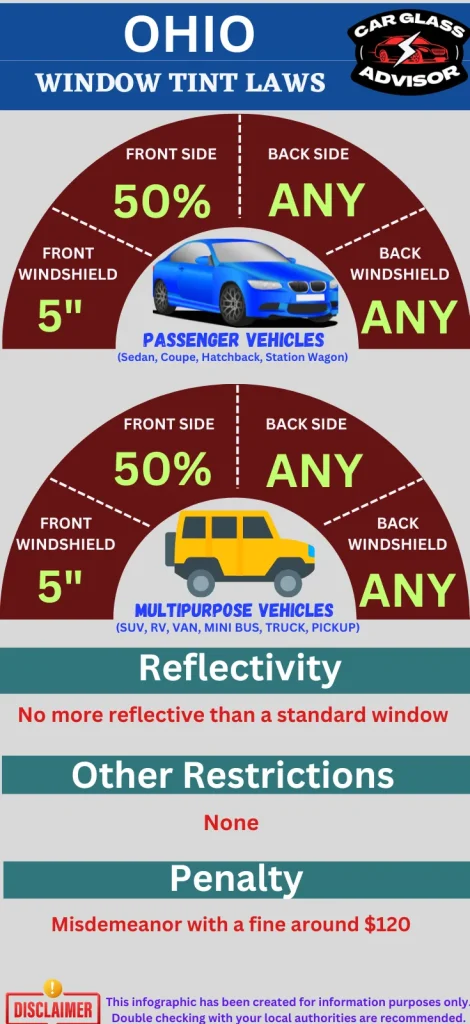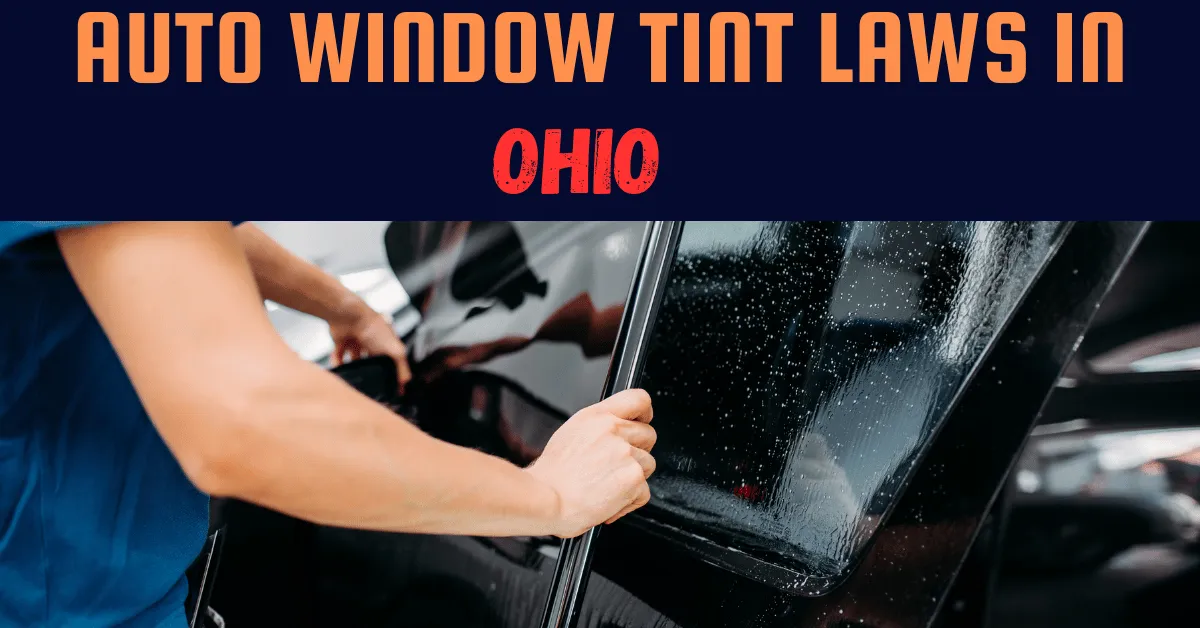Back in 2004, Ohio set forth its car window tinting laws, which regulate the level of darkness and reflectiveness permitted on car windows. As a responsible driver, it’s crucial to familiarize yourself with these regulations to avoid any unwanted fines. To help you stay on the right side of the law, I’ve gathered all the information and documentation on Ohio’s car window tinting laws. Along with the specifics on tint darkness and reflectiveness, there are a few other rules and regulations you should know about. Keep reading below to ensure you’re up-to-date on Ohio’s car window tinting guidelines.
Auto window tinting is an important decision, and you need to be aware of two things in Ohio: Visible Light Transmission (VLT) and Visible Light Reflection (VLR). In this discussion, You’ll explore both concepts, beginning with VLT.
1. Legal Window Tint Darkness in Ohio (VLT)
Window Tint Darkness or Visible light transmission (VLT) is a measurement of the amount of light that passes through a film. It’s measured in percentages and can vary from 0% to 100%. The higher the percentage, the more visible light is transmitted through the film.
Every state has a certain legal limitations. Therefore, for car window tinting, the regulations in Ohio are unique and may differ from those in other states. Here, the amount of light that’s permitted to pass through tinted windows varies based on the type of vehicle, whether it’s a passenger vehicle or a multi-purpose vehicle. It’s crucial to read Ohio’s tinting laws carefully to ensure you’re compliant with the rules. Don’t take any chances for your car’s tinting—make sure you understand the guidelines and stay on the right side of the law.
Tint darkness laws for passenger vehicles (sedans) in Ohio:
Windshield: You can non-reflective tint on the top 5 inches of the windshield.
Front Side windows: You can use up to 50% tint darkness.
Back Side windows: You can use any tint darkness for backside windows.
Rear Window: You can use any tint darkness for rear windows.
Tint darkness laws for multi-purpose vehicles (SUVs and vans) in Ohio:
Windshield: You can use non-reflective tint on the top 5 inches of the windshield.
Front Side windows: You can use up to 50% tint darkness.
Back Side windows: You can use any tint darkness for backside windows.
Rear Window: You can use any tint darkness for rear windows.
2. Legal Window Tint Reflection in Ohio (VLR)
Window Tint Reflection or Visible light reflection (VLR) is the amount of light that a window film reflects. The permissible level of window reflection (VLR) when using window tint is measured in percentages, ranging from 0% to 100%. A lower VLR percentage means that less visible light is reflected into the car, resulting in more sunlight being blocked. It’s crucial to pay attention to the VLR percentage as well when selecting window tint for your vehicle, to ensure that you comply with Ohio’s window tint laws. Make sure you’re aware of all the regulations and guidelines related to window tinting in Ohio, including the VLR percentage, to avoid any potential fines or penalties.
Tint reflection laws for passenger vehicles (sedans) in Ohio:
Front Side windows: You can’t use any reflective materials on the front side windows.
Back Side windows: You can’t use any reflective materials on the back side windows as well.
Tint reflection laws for multi-purpose vehicles (SUVs and Vans) in Ohio:
Front Side windows: You can’t use any reflective materials on the front side windows
Back Side windows: You can’t use any reflective materials on the back side windows as well.
Other Ohio Window Tint Rules and Regulations:
Ohio is pretty serious regarding window tinting of your vehicle. You will have to obey plenty of rules and regulations. Besides maintaining a specific percentage of the darkness and glare on each window, here are some other rules and regulations you need to follow as well.
Side Mirrors: Ohio law does not place any restrictions on the use of side mirrors. This means that drivers are free to use side mirrors of any size or shape, as long as they provide the driver with a clear and unobstructed view of the rear and side of the vehicle.
Restricted Colors: There are no restrictions on the colors of tint that can be used in Ohio. Drivers are free to choose any color of tint they prefer, as long as it meets the other legal requirements outlined in Ohio law.
Certificates: Manufacturers of film used for tinting are required to certify the film they sell in Ohio. This ensures that the film used is of high quality and meets all safety and performance standards. When purchasing film for your vehicle, it is important to ask your dealer if they are using certified film.
Stickers: Ohio law requires that a sticker be placed on each tinted window to identify that the tinting is legal. This sticker must be placed between the film and the glass of each tinted window. The sticker should be easy to see and should be able to be read from outside the vehicle.
Medical Exceptions: Ohio law does not make any mention of medical exemptions for special tint. This means that if you have a medical condition that requires the use of a special tint, you will need to follow the same laws and regulations as all other drivers in Ohio.
Penalties: Violating Ohio’s tint laws is considered a misdemeanor and carries a fine of around $120. Repeat offenders may face higher fines, and it is possible that they may have their driver’s license suspended or revoked. It is important to always follow Ohio’s tint laws to avoid penalties.

Conclusion
In Ohio, the permitted tint darkness for passenger vehicles (sedans) is as follows: the windshield can have non-reflective tint on the top 5 inches, front side windows can have up to 50% tint darkness, back side and rear windows can have any tint darkness. The same rule applies for multi-purpose vehicles such as SUVs and vans, where the windshield can have non-reflective tint on the top 5 inches, front side windows can have up to 50% tint darkness, back side and rear windows can have any tint darkness. Additionally, manufacturers of film used for tinting are required to certify the film they sell in Ohio, and a sticker is required to be placed on each tinted window to identify that the tinting is legal. Violating Ohio’s tint laws is considered a misdemeanor and carries a fine of around $120.
Disclaimer
The information on this site is provided for informational purposes only and should not be construed as legal advice or as a substitute for the advice of an attorney. No user of this site, or any other person or entity that may have received this information, shall rely upon the information contained as creating an attorney-client relationship between such user and Car Glass Advisor. The rules and regulations pertaining to car window tint in Ohio may change at any time. Therefore, please contact a local lawyer licensed to practice in your jurisdiction.

